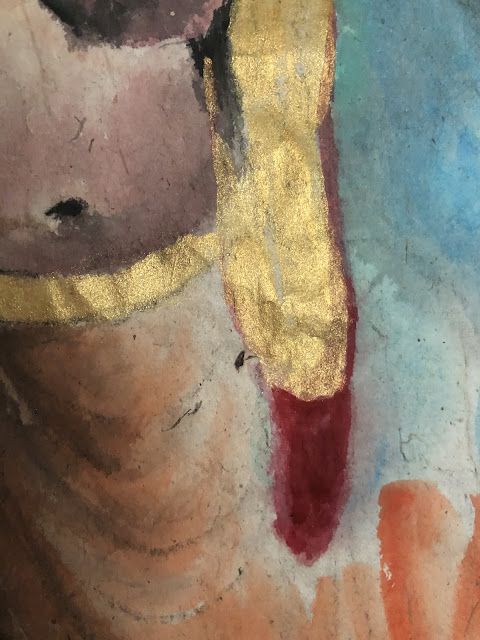The last couple of years taught me to subscribe to the KISS axiom. Keep It Simple, Stupid. The participants could range from 4 years old toddlers to 80 years old seniors. My presentation should be focused on fun, and result oriented. My job is not to "teach" painting, but rather as a facilitator so that everybody will have fun and a sense of accomplishment after painting their own pieces.
I'm sticking with the Zhu Bajie character. Most Chinese would be familiar with him and identify him as the celebrity pig, and for everyone else, it should be fun to be exposed to a little Chinese trivia.
Obviously I am going to simplify the image I posted on New Year's day. My plan is to single out the 2 characteristics of the meme; a snout and a pudgy face. If a person can nail these two traits, then a pig is born. The rest of the painting will just be along for the ride and should not significantly affect the outcome of the painting.
So that I can be consistent with my presentation and get guaranteed results, I've devised the following game plan;
I would have participants mark off the paper into roughly thirds. At the top one-third line start by drawing a oblong circle, representing the snout of the pig. Under the snout, write in a thick line for the mouth opening, followed by the lower lip.
Next comes eyes
Now we would assign the pudgy cheeks and the brows. I want the presence of the cheeks to dictate the persona of the pig. The open mouth and the round cheeks should give off a sense of where this painting is going.
A pair of floppy ears are now attached to the face. A cap with an ornament (typically jade) tops off the upper contour of the head.
The snout is now associated with nostrils and the skin folds on the ridge. The nose is no longer two-dimensional.
Eyeballs are now seated, following the notion that they bestow spirit to the being.
The pose is for Zhu to be holding a scroll or banner, bearing an auspicious writing; the Fai Chun. The tradition of decorating with Fai Chun is quite popular with the Chinese culture, even today. The calligraphy is typically done on red paper, the color of jubilation. The words convey blessings and fortune. The calligraphy is then used to decorate an entry way, such that one's ingress and egress is always blessed.
Now that we have the head finsihed, the rest of the body should just flow. I shall start on the right shoulder, and a horizontally bent elbow. Participants will be asked to paint 4 closed bracket signs to emulate fingers. If I ask them to paint fingers, invariably a roadblock barges in. People would claim no prior experience of painting digits. Now closed brackets are a different story. Everybody, except for the very young, knows what they look like. Asking the audience to write brackets takes away the fear or hesitation. The fingers are to be positioned somewhere around the bottom-third marking.
Collar is written in and a robe is draped over the arm, extending to the bottom of the paper. I don't think the exact proportion matters that much. For all practical purposes, we are painting a fictional figure to begin with. Who's to say the arm or fingers are too long or short. Zhu is however you imagined, as long as it is a pig.
We can now proceed to the left side of Zhu. Here the fingers are represented as open brackets or a series of the letter C. A waist belt is fitted and the bottom garment painted in. Paint in a rectangle to fit between the upper fingers and the lower fingers and we have ourselves a banner.
I do not expect the participants to be able to write the Chinese characters. I therefore wrote 3 different versions of the Fai Chun myself and took pictures
This is the cliche "Happy New Year"
"Safe Entry and Exit, safe journey"
"The wind suits well, and the rain is all right" ( Everything is going my way)
These calligraphy pieces were then printed on red construction paper. They were cut up into individual pieces, which would go on the banner in the painting.
So these pieces of red strips are actually the hook for the painting project. Once the person is finished with his/her painting, they can choose their Fai Chun and glue it in place.
Now all participants will have a finsihed piece to bring home. A piece that looks polished, and a meaningful memorabilia for the Year of the Pig. They themselves painted the piece; and that is the only thing that matters.
































































